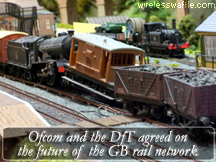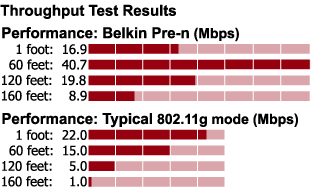Thursday 30 August, 2018, 14:45 - Spectrum Management, Much Ado About Nothing
Posted by Administrator
Posted by Administrator
 Ofcom has published a report called "Advice to Government on improving rail passenger access to data services, Spectrum for trackside connectivity solutions and rail passenger data demand". In it, they examine the amount of data needed to supply connectivity to passengers and then which spectrum band is best suited to supply these needs.
Ofcom has published a report called "Advice to Government on improving rail passenger access to data services, Spectrum for trackside connectivity solutions and rail passenger data demand". In it, they examine the amount of data needed to supply connectivity to passengers and then which spectrum band is best suited to supply these needs.The amount of data that each passenger will be consuming each month is taken directly from Ofcom's "Mobile Data Strategy" which was published in 2016. These range from 50 to 200 Gbytes per month in 2025 depending on the scenario. The report assumes that 80% of this data is offloaded onto WiFi and that it will be a WiFi service that is provided on the train.
 If this is the case, the average user will consume between 40 and 160 Gbytes of WiFi data per month, which is 1.3 to 5.3 Gbytes per day. If we take Ofcom's figures that there will be between 600 and 1440 passengers on busy commuter trains, and that a typical commute on a train lasts 1 hour, then the total amount of data per hour consumed by all the passengers between 33 and 315 Gbytes. This, in turn, equates to a connectivity requirement of between 73 and 700 Mbps. Of course, this assumes that every passenger on the train uses the WiFi service that is provided, which is unlikely to be the case, especially (as Ofcom also notes) if the service requires a payment to connect to.
If this is the case, the average user will consume between 40 and 160 Gbytes of WiFi data per month, which is 1.3 to 5.3 Gbytes per day. If we take Ofcom's figures that there will be between 600 and 1440 passengers on busy commuter trains, and that a typical commute on a train lasts 1 hour, then the total amount of data per hour consumed by all the passengers between 33 and 315 Gbytes. This, in turn, equates to a connectivity requirement of between 73 and 700 Mbps. Of course, this assumes that every passenger on the train uses the WiFi service that is provided, which is unlikely to be the case, especially (as Ofcom also notes) if the service requires a payment to connect to.Having presumably done the same calculations, Ofcom has arrived at a requirement of between 400 Mbps and 3.6 Gbps, or roughly 5 times more. So either train journey in Ofcom's world are 5 times longer, or people on trains are 5 times more hungry for data than normal individuals.
 Based on these figures, Ofcom have assumed that a benchmark connectivity speed should be around 1 Gbps for trains. It has then gone on to analyse the various spectrum options, and decided that the only band that can deliver the necessary connectivity is the 26 GHz band, which is one of the bands being touted for future 5G services. It completely excludes, for example, the use of the 2.7 - 2.9 GHz band as it claims that this could only deliver 100 Mbps of connectivity (assuming that 40 MHz of it could be made available). It also discounts the 5.4 GHz band as this could only deliver 'a few hundred Mbps'.
Based on these figures, Ofcom have assumed that a benchmark connectivity speed should be around 1 Gbps for trains. It has then gone on to analyse the various spectrum options, and decided that the only band that can deliver the necessary connectivity is the 26 GHz band, which is one of the bands being touted for future 5G services. It completely excludes, for example, the use of the 2.7 - 2.9 GHz band as it claims that this could only deliver 100 Mbps of connectivity (assuming that 40 MHz of it could be made available). It also discounts the 5.4 GHz band as this could only deliver 'a few hundred Mbps'. There are, though, significant issues with the 26 GHz band:
- Coverage of a 26 GHz 'cell' is expected to be a few 100 metres only, which would mean tens of thousands of cells would be needed to cover the UK rail network.
- Trains run at up to 200 km/h, this places extreme demands on handovers if cells are close together, let alone dealing with Doppler shift and Rayleigh fading.
- The 26 GHz band has been identified as a 'pioneer' band for 5G services in Europe and is likely to be in high demand from mobile operators for their future mobile services.
 There is, however, a very simple solution to the whole problem. If we shrink the size of the rail network to be only a few hundred metres long, then the 26 GHz solution will work perfectly. This, perversely, seems to be the plan of the Department for Transport who allow companies such as Southern, Thameslink, Hull Trains and Northern Trains to implement new timetables that effectively reduce the rail network to set of toys, that can't convey passengers anyway. Bravo, Ofcom, for realising that the rail industry will be reduced to OO-gauge before long anyway.
There is, however, a very simple solution to the whole problem. If we shrink the size of the rail network to be only a few hundred metres long, then the 26 GHz solution will work perfectly. This, perversely, seems to be the plan of the Department for Transport who allow companies such as Southern, Thameslink, Hull Trains and Northern Trains to implement new timetables that effectively reduce the rail network to set of toys, that can't convey passengers anyway. Bravo, Ofcom, for realising that the rail industry will be reduced to OO-gauge before long anyway.add comment
( 505 views )
| permalink
| 



 ( 2.9 / 3615 )
( 2.9 / 3615 )




 ( 2.9 / 3615 )
( 2.9 / 3615 )
Saturday 27 January, 2018, 09:04 - Spectrum Management, Much Ado About Nothing
Posted by Administrator
It seems that we, here at Wireless Waffle are having a bit of a spate of 'told you so' type events at the moment. Last month we spotted that Vodafone had been rapped over the knuckles for their crafty roaming fee shenanigans. Now we have spotted that Ofcom have been called out to assist drivers who couldn't lock or unlock their cars due to radio interference.Posted by Administrator
 On various occasions we have discussed how straightforward and relatively widespread the jamming of the frequencies used for your car keyfob is. Last time we discussed this it was because some miscreants had latched onto the idea and were stopping people locking their cars so that they could easily break in (more like stroll in) and take whatever they found in the glove compartments, foot wells and boots of the rich and not-so-rich.
On various occasions we have discussed how straightforward and relatively widespread the jamming of the frequencies used for your car keyfob is. Last time we discussed this it was because some miscreants had latched onto the idea and were stopping people locking their cars so that they could easily break in (more like stroll in) and take whatever they found in the glove compartments, foot wells and boots of the rich and not-so-rich. The Ofcom story is even more worrying as it suggests that jamming these devices is far easier than even we though possible. In addition to the car keyfobs we are so keen on discussing, the same frequency range (433 MHz) is also used for a wide variety of other wireless devices including wireless doorbells. These devices are relatively low power (10 milliWatts) and the idea is that they shouldn't interfere with each other as the range of transmission is very small. It seems, however, that a button on one such doorbell got stuck in the 'on' position, meaning it was constantly transmitting. This was enough to stop people in the vacinity locking and unlocking their cars. Thankfully, the brave Ofcom engineers were able to track down the problem and sanity was restored. Hurrah for Ofcom!
The Ofcom story is even more worrying as it suggests that jamming these devices is far easier than even we though possible. In addition to the car keyfobs we are so keen on discussing, the same frequency range (433 MHz) is also used for a wide variety of other wireless devices including wireless doorbells. These devices are relatively low power (10 milliWatts) and the idea is that they shouldn't interfere with each other as the range of transmission is very small. It seems, however, that a button on one such doorbell got stuck in the 'on' position, meaning it was constantly transmitting. This was enough to stop people in the vacinity locking and unlocking their cars. Thankfully, the brave Ofcom engineers were able to track down the problem and sanity was restored. Hurrah for Ofcom!Far be it for us to opine on the implications of this, but taking the earlier example from the BBC in which miscreants were jamming car locks but haven't Ofcom just provided these folk (and others with a similar inclination) with a simple, cheap and undetectable means of achieving the same outcome?
Just get hold of the push-button part of a wireless doorbell, put this in your pocket, and wander around a car park where posh cars park (maybe even buy a hi-viz jacket so it looks as if you are meant to be there). If it's a supermarket car park, collect a few trollies whilst you're waiting. When a particularly rich looking owner appears, go and stand close to their car and as they get out and get ready to press the button on their key to lock it, activate the wireless doorbell button. 'Hey presto', the car won't lock and you will be able to help yourself to their Gucci loafers and other luxury goodies.
From a radio spectrum management and perhaps more specifically a Wireless Telegraphy Act perspective, no law has been broken. From a Theft Act perspective, however, you still stand to be charged (or sit, depending on the layout of the court room).
Thanks Ofcom!

Posted using my gold-plated iPhone X, whilst wearing Gucci loafers and sipping Bollinger RD '85 on my luxury yacht moored in Saint Tropez with my 3 Aston Martins parked alongside.
Sunday 29 October, 2017, 21:19 - Much Ado About Nothing
Posted by Administrator
Posted by Administrator
 Just a quick reminder, as Halloween is but 2 dastardly days away, to take a look at our list of One Hundred Halloween Hits.
Just a quick reminder, as Halloween is but 2 dastardly days away, to take a look at our list of One Hundred Halloween Hits.The list of horrendous hell-bound hits has now easily exceeded a blood-curdling century, but 'one hundred and sixteen and a bit Halloween hits' doesn't have quite the same ghastly ghoulish ring to it, now does it?
If you need a playlist for your All Hallows' Eve party, look no further than this fiendish selection of scary songs. Get ready to be afraider than you've never been before.
And if you don't know your Zombie from your Lil' Devil, or your Highway From Hell from your Road To Hell, this list is for you!
Friday 22 September, 2017, 09:12 - 5G, Spectrum Management, Much Ado About Nothing
Posted by Administrator
Posted by Administrator
 Whilst much of the world is yet to experience the joy of 4G (LTE) mobile technology, work is ongoing in a variety of prestigious international bodies to put the finishing touches to the specifications for the next generation of mobile technology: 5G. Everybody knows that 4G stands for GGGG, or the stuttering noise you get when buffering a video, but what are the five G's? Simple, it's Girls, Goals, Gambling, Gaming and videos of Grimalkins, which are the cornerstones upon which mobile technologies aim to make their fortune.
Whilst much of the world is yet to experience the joy of 4G (LTE) mobile technology, work is ongoing in a variety of prestigious international bodies to put the finishing touches to the specifications for the next generation of mobile technology: 5G. Everybody knows that 4G stands for GGGG, or the stuttering noise you get when buffering a video, but what are the five G's? Simple, it's Girls, Goals, Gambling, Gaming and videos of Grimalkins, which are the cornerstones upon which mobile technologies aim to make their fortune. Slightly more seriously though, oodles is already beginning to be written about what 5G will deliver, which includes a range of features such as:
- Blazing hot, super, ultra, mega-fast broadband internet.
- Ubiquitous, go-everywhere, global, universal coverage (even in those hard to get at areas such as behind the sofa).
- Instantaneous, low-latency, tactile, real-time connectivity.
- Extremely high reliability, such that the network will only be down for 14 seconds per millennium, which together with low-latency mentioned above, is termed Ultra-Reliable Low Latency Communications (URLLC).
- Capacity to connect thousands of billions of machines (such as coke vending machines and tumble dryers) known as Massive Machine Type Communication (MTC).
- Power consumption so low that batteries only need re-charging once in every 4 years and base stations can run on one lemon per month.
- World peace and an end to global poverty and disease (this might be made up).
5G is being touted as the 'mobile technology to end all mobile technologies' and as a panacea for all ailments. This miraculous technology will provide what some have termed an 'always sufficient connection' which gives the impression of infinite bandwidth - yes, infinite.

- Mobile subscriber numbers have levelled off and average revenue per user (ARPU) is in gentle decline.
- The 5G vision has not been coupled with a business case. The business reality is that there is no new money.
- The business case for the 'jewel in the crown' of 5G � its millimeter Wave (mmWave) solution � makes little sense.
- Regulators and the ITU should not focus on spectrum for 5G - instead they should ensure that spectrum is available for each component [e.g. broadband, critical communications and IoT].
- Academics should have a stronger links to business departments in universities to ensure that technical breakthroughs are actually valuable.
- Large players (e.g. Ericsson, Nokia, Qualcomm, Huawei, Cisco and Google) should stop believing that the future is all about Gbit/s data rates.
- Governments should focus on deployment, applications and over-the-top (OTT) services not just spectrum.
 What is odd about both sides of the argument, is that many of the so-called advantages of 5G can almost certainly be delivered by 4G (LTE), especially by the forthcoming super-4G variant known as LTE-Advanced-PRO (3GPP LTE Release 13 and 14) - often termed 4.9G. All that 5G really brings is an explosion in the number of cell sites (which could occur using 4G) and technologies and techniques to allow access to new mmWave spectrum above 24 GHz which, according to Verizon may not be great for mobile services anyway:
What is odd about both sides of the argument, is that many of the so-called advantages of 5G can almost certainly be delivered by 4G (LTE), especially by the forthcoming super-4G variant known as LTE-Advanced-PRO (3GPP LTE Release 13 and 14) - often termed 4.9G. All that 5G really brings is an explosion in the number of cell sites (which could occur using 4G) and technologies and techniques to allow access to new mmWave spectrum above 24 GHz which, according to Verizon may not be great for mobile services anyway:Delivering mmWave broadband connectivity in non-line-of-sight environments, such as suburban and urban areas, is extremely problematic over the last quarter mile, because of foliage and solid constructions.
The European Commission believes that 5G is important. Its 5G Action Plan encourages each and every Member State to have a 5G service in at least one city in their country by 2020. Whether this could be delivered using 4.9G to the satisfaction of the Commission is not clear but Ericsson's definition of a 5G subscription in its Mobility Report is:
a device capable of supporting LTE Evolved or NX, connected to a 5G-enabled network, supporting new use cases
This is effectively saying that 4.9G LTE-Advanced-PRO connections would be considered as 5G subscriptions.
The reality is that the real 5G specifications will not be completed until 2020, hence any service delivered before that date can be a 'pre-5G' service at best - or maybe 4.9G. Plans for 5G services in each EU Member state, at the Winter Olympic Games in Korea in 2018 and the Tokyo Olympic Games in 2020 can only possibly fall into the pre-5G category as there will be no agreed 5G standard by these dates.
That being said, there was a time when the World was awash with 'pre-N' internet routers, which were built before the relevant standard (IEEE 802.11n) was completed. The issue with such pre-standardisation products is generally one of interoperability. Each manufacture would have had to have implemented a variation of the standard as they thought it would be finally ratified and these may have been different. Thus whilst a pre-N Netgear router may have worked with a pre-N Netgear WiFi dongle, it wasn't guaranteed to work with a TP-Link, Belkin or a Linksys one.
 For WiFi, that's probably not such a big problem, not least as if the 'N' connection failed, the router and dongle could fall back to an agreed, but less whizzy standard such as 802.11g and thus whilst the benefits of the newer standard wouldn't be realised, the WiFi would still work.
For WiFi, that's probably not such a big problem, not least as if the 'N' connection failed, the router and dongle could fall back to an agreed, but less whizzy standard such as 802.11g and thus whilst the benefits of the newer standard wouldn't be realised, the WiFi would still work. This may be what happens with the pre-5G mobile networks. Japan, for example, has a number of domestic mobile phone manufacturers (e.g. Sony, Sharp, Panasonic) who could agree to make pre-5G phones to whichever standard the Japanese mobile operators chose to roll-out. But for anyone else visiting the country (e.g. for the 2020 Olympic Games) with phones made by other manufacturers, they would just fall back to 4G and not enjoy the benefits of 5G. In such a way, Japan could claim to be offering a 5G service, but it would not be one that was internationally compatible.
So whilst 5G may yet save the world, it is unlikely to do so by 2020 unless you happen to live in a country which has its own mobile manufacturers, live in one of the minute areas where coverage will exist, happen to be there on a day when the 5G service is actually working, and have bought a locally produced 5G phone (or have been provided with one as a guinea pig to test the service). For the rest of us, its going to be more like 2023 or 2025 before real 5G services begin to make a difference to our daily lives and the (perfectly adequate) 4G service we already enjoy will, for now, have to be largely sufficient (though this doesn't make such a compelling strap-line for mobile operators' marketing departments).


